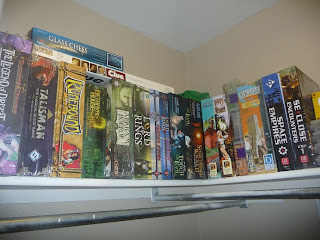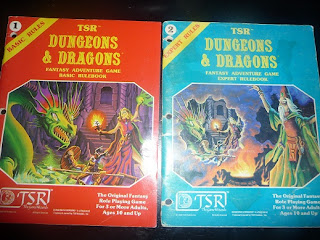
Non-combat encounter systems are a common feature in modern game books. This is the meat and potatoes of modern game design, everything else is periphery. However, there really is no hard and fast written rule in any of the early gaming books to describe how this is done, unless you count some of the, "in case you can't come up with a way to resolve an encounter, roll a d%", bits in some of the text. I think it was generally assumed a matter of DM fiat, mixing and matching what he thought was best for each situation. Some use equivalency rules consisting of % dice similar to the Thief tables. Some use a hackneyed universal die roll system that mimics 3Es D20 system (like Castles & Crusades Siege Engine). I've even see a few who go by the rules exactly as written, meaning there is no possible way for a fighter to climb a wall. Ever. There are others who simply throw out ability scores altogether or nerf them, relying on player level and class only. Others rely mostly on player skill and very little on character skill at all and vice versa.
I've used a combination of some of the ideas above, but I personally reject any kind of universal roll mechanic for all classes. I personally believe that the D20 mechanic (or any unifed die mechanic) was the worst thing to happen to RPGs as it caused role-playing to go flying out the window. My favored system is a combination of die roll, character skill and player skill all wrapped into one. Over the years, I've found this incorporates the best of both worlds, and simply feels to me like the way the game was meant to be played. So here it is:
-----------------------------
All non-combat skill is resolved based on a balance between two opposing forces which I call positive and negative factors. In modern gaming terms, this would be called "skill vs DC", but since I hate modern gaming, and my definition of "skill" is far more encompassing, I've changed the terms up a bit (I dont actually refer to this in my games, but here it is for explaining purposes). Each basically boils down to the following:
Positive Factors (PFs)
1. Player Ability (The character's soul)
2. Character Ability:
a. Skills
b. Race
c. Class
d. Level
e. Ability Score
f. Equipment
g. Health/History/Genetics
h. Cosmetics (age, gender, appearance, etc)
i. [Anything else about the character I've missed]
--VS--
Negative Factors (NFs)
Conditions:
a. Opposing NPC factions
b. Terrain
c. Weather
d. Character Health/History/Genetics
e. [Anything else about the environment I've missed]
Most of the above is a no-brainer, we all take these things into consideration when resolving encounters. The only major difference you may find with my list is the relationship between player ability and character ability and how they can be used together. A player's ability can be thought of as the character's soul, will, determination, or self-esteem - the conscious voice inside all of us that can either guide us to better realities or belie our reality. Understanding this is the most critically important aspect of my system. We often -believe- we can do something well or not well in contrast to our physical limitations. A person, for example, may believe that they are great singers, but the reality is that they are terrible [See American Idol]. On the other hand, someone may underestimate their ability to cook and then impress others when attempted. So just like the real world, in the world of fantasy Role-Play of D&D, we are always tempering our personal, player skill against the physical limitations of reality within the game itself.
Simple game example:
Jason plays Bo the Half-Orc fighter, a character with low charisma, but a large strong frame. He and a party of adventurers have snuck into the palace through the sewers and have been caught in the act by two human guards in the prison dungeon. In real life, Jason is a high school debate champion so Jason's character approaches the guards and begins to explain an incredible story to outwit them.
The Dungeon Master makes a judgement call using relevant factors that would make the difference in a conversational challenge. Because of Bo's lack of charisma, the DM explains that what came out of his mouth was not nearly as eloquent as Jason imagined. But because the performance was so masterful and the stature of the half-orc was a little terrifying, the DM allows for one of the guards to be fooled while the other is not convinced.
The result is a small quarrel between the guards giving the party time to either gain surprise in combat, flee, or take other measures.
[Note that no die rolling was used in the example above]
---------------------------------------------
In this example, the DM made a call using the relevant PFs vs NFs above. Some circumstances may require dice, however, because sometimes situations arise that necessitate random factors coming into play. In other words, random factors are those PFs and NFs that are so small and insignificant that they would slow the rate of play down far too much. A wandering mind during spell casting, an itchy index finger of a climber, a small gust of wind, and the distracting smell of rotting flesh while fleeing from zombies. Because these minor distractions (or bonuses) DO actually happen in real life, the dice is a way to simulate that. But let me be clear: The dice should not be used to simulate large factors that can be controlled and/or obviously noticed by the PCs, NPCs, and DM involved. Climbing a wall during a tornado, or even a rainstorm, is a stupid idea, plain and simple, and dice rolling is not necessary.
One thing I do allow in my games is the option to give your character bonus abilities and weaknesses. A player can come up with these during character creation when making up a history, or they can be acquired during play. An example would be a character who was raised on a farm and has an knack for taming animals and identifying plants and herbs, but was gored once by a bull and lost an eye. These are my old-school answer to new-school feats, other PFs and NFs that can come into play during game-play encounters.
Some characters include more defined roll tables to obtain these random factors, like the Thief. The most important thing to remember is that these random factor tables are simply a shortcut, not an advantage. When the Thief makes the decision to climb a wall he may choose to roll on the random table or he may use OTHER Positive Factors in his arsenal. Because the Thief is so skilled at doing his "thiefy" things, he can take these kind of short-cuts that others cannot, but that does NOT mean he must always exclude player ability to resolve such thing. The choice is his, unlike the fighter who must always use player ability as his starting point. Such things could include his intelligence score, equipment he is carrying, and his race. Sometimes rolling is dangerous because it disallows for Player Ability completely. Only in the simplest of challenges should rolling be used. Any character class can attempt to climb a wall, but the difference is that they do not have access to the Thief shortcut.
Example
Kerik the Thief approaches a 5' x 8' x 10' pit trap. He may either attempt to bypass the pit trap by using his innate % abilities by rolling dice, OR he may decide to role-play out the situation. There is a danger to both approaches. Relying solely on the dice roll means you are putting your life into the hands of your past training, you are RELYING on old skills that may or may not come to you. In this case, Kerik rolls the die because the trap is fairly simple. Failing would not mean much damage, and by doing so he can quickly get across before his non-thief companions can come up with a role-played solution.
Later on, Kerik comes across a trapped chest, covered in black widows, hanging from a thin strand of webbing over a 100 foot chasm. In this case, rolling the dice would be foolish. Kerik relies on his player ability PLUS his PFs to bypass the trap and obtain the treasure. Again, as we discussed earlier with the Half-Orc. Kerik's player ability (PF 1) is measured against (PF 2) to obtain a result. Kerik decides that he will use his torch to burn the spiders off while swinging the chest toward the ledge with his 10-foot pole. Sounds like a good plan, except for the fact that the torch ends up burning the webbing too quickly, causing the chest to fall straight into the chasm. However, Kerik has a Dexterity of 15, and the DM decides that it is just BARELY enough character ability to overcome Kerik's player's ability to win the treasure successfully.
Now, had Kerik failed the previous pit trap and caused 2 points of damage, the DM could have decided that Kerik's knees where bruised causing him to move a little less accurately. This could have caused him to miss the falling treasure altogether.
So, you see how in my games Player Ability (PF 1) and Character Ability (PF 2) come to work together, sometimes bailing out a poor role-player, and sometimes ruining a good one. The DM makes a quick decision based on all factors (or as many as he can think of) in a non-combat situation to resolve it.
A good RP performance by a player can certainly help a situation, but it cannot completely override his character, just as "heart" and determination cannot always override muscle and brain power.
As an Eagle Scout myself, I am an admirer of Bear Grylls, the current
Chief Scout, and star of the popular series, "Man vs Wild". Here is a man that has an astonishing control of the negative factors in his environment. There is clearly a lot of control and planning in place when things go wrong for safety concerns, but much of what he does is real and very dangerous. If Bear was part of a D&D game, it wouldn't make a lot of sense to put his fate into dice because he has such a mastery over the elements. It is clear that the vast majority of what he accomplishes happens primarily because of the intelligent decisions he makes, and not because of chaos in the universe "willing" him to succeed (dice rolling).
I cringe a little when I see DMs constantly asking for dice checks in games. Train your players to make intelligent, vigilant decisions whenever tough situations arise and help them rid themselves of their habit of relying on dice as a shortcut out.
-----------------------------------
To sum things up:
All non-combat encounters rely equally on both
Player Skill and Character Skill that balance each other out. A player cannot completely override his character's ability, nor can a character completely override his player's ability, EXCEPT for certain classes which have inherit shortcut skills like the thief that can be used at his own risk. Dice rolling ought to be the exception to the norm, a tool relied upon only in the simplest of situations.
I've never seen an encounter resolution system quite like this one and hopefully I may give someone else some ideas. I honestly believe this is the most accurate way to play classic D&D and that this is the spirit of the old-school game as it was designed to be played. I've come to rely on it every time I play and have found a lot of success from using it.



























